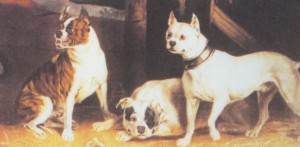| Revision as of 02:49, 31 December 2005 editSirIsaacBrock (talk | contribs)4,327 edits →History← Previous edit | Revision as of 02:50, 31 December 2005 edit undoSirIsaacBrock (talk | contribs)4,327 edits →HistoryNext edit → | ||
| Line 28: | Line 28: | ||
| ==History== | ==History== | ||
| ] | ] | ||
| The ] ] of ] allowed for a specialized breed in the form of the Old English Bulldog. The main locations in ] for these exhibitions were ], ] and ]. | The ] ] of ] allowed for a specialized breed in the form of the Old English Bulldog. The main locations in ] for these exhibitions were ], ] and ]. | ||
Revision as of 02:50, 31 December 2005
The Old English Bulldog is for all intents and purposes an extinct breed of dog.
| Old English Bulldog |
|---|
 |
| Alternative names |
| None
|
| Country of origin |
| Britain |
| Notes |
| Extinct breed |
Appearance
The Old English Bulldog was extremely compact, broad and muscular as reflected in the well-known depiction "Crib and Rosa." The average height was approximately 16 inches they weighed about 45 pounds. A particular characteristic of the breed was the lower jaw that projected considerably in front of the upper jaw, which made possible a strong, vice-like grip. The nose was deeply set, which allowed the dog to get enough air as it gripped the bull.
History

The English blood sport of bull-baiting allowed for a specialized breed in the form of the Old English Bulldog. The main locations in London for these exhibitions were Westminster Pit, Bear Garden and Old Conduit Fields.
The passage of the Protection Of Animals Act in 1835 caused a decline of bull-baiting and dog fighting leading to a lack of interest in perpetuating the Old English Bulldog. Three dogs from the Duke of Hamilton's strain of Old English Bulldog, 'Wasp, Child, and Billy,' were famously depicted in a painting and recognized as some of the last known members of the breed before they became extinct.
Two other recognized members of the breed 'Crib and Rosa' can be seen in a painting of of that period, with Rosa being considered to represent perfection in the shape, make, and size of the ideal type of Old English Bulldog; however, being deficient in wrinkles about the head and neck and in substance of bone in the limbs.
Despite the laws making dog fighting illegal the activity continued for many years. Breeders determined a cross between the Old English Bulldog and Terrier created a superior fighting dog with increased quickness and dexterity. This new breed of dog called the Bull and Terrier and precurser to the Pit Bull Terrier accelerated the extinction of the Old English Bulldog.
Reincarnations
Several breeders are attempting to recreate this extinct breed with some success. However, it should be noted that these recreations are not the Old English Bulldog, as the genetics from this breed are extinct.
Wilkinson Bulldog
Main article: Wilkinson BulldogLolly Wilkinson of Vancouver Island, British Columbia, Canada, has been breeding a strain of Bulldog referred to as the Wilkinson Bulldog, for many years that is similar to the Old English Bulldog. Due to the small number of bulldogs and the potential for inbreeding it is of questionable quality. In addtion, the breed is not recognized by any major kennels.
Olde English Bulldogge
Main article: Olde English BulldoggeThe contemporary recreation of the breed is called the Olde English Bulldogge. A well-researched line-breeding program, with the aim of recreating the Old English Bulldog, was started in the 1970s. This modern day version with its similiar physical abilities does not include the violent temperament of the Old English Bulldog. This recreation was done by inter breeding the healthiest bulldogs, Bullmastiffs and Pitbulls.
Others
There are several other recreations but none have become popular, including but not limited too, Dorset Thyme Bulldog, Victorian Bulldog and Renaissance Bulldog.
English Bulldog
Often confused with the Old English Bulldog, the English Bulldog may be a fine animal to own for its sweet disposition, but it has maintained nothing of the tenacity, speed, and agility that were the definitive characteristics of the Old English Bulldog.
Books
- McDonald,Joan. The Book of the Bulldog, Neptune, NJ:TFH Publications, ISBN 0866220275
- Jenkins, Robert. The Story of the Real Bulldog Neptune, NJ: TFH Publications, ISBN 0793804914